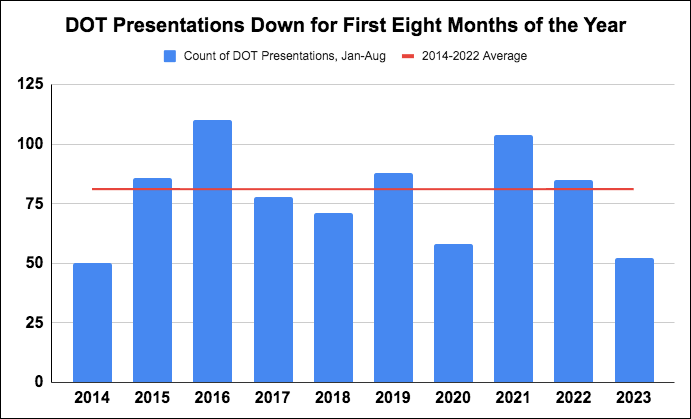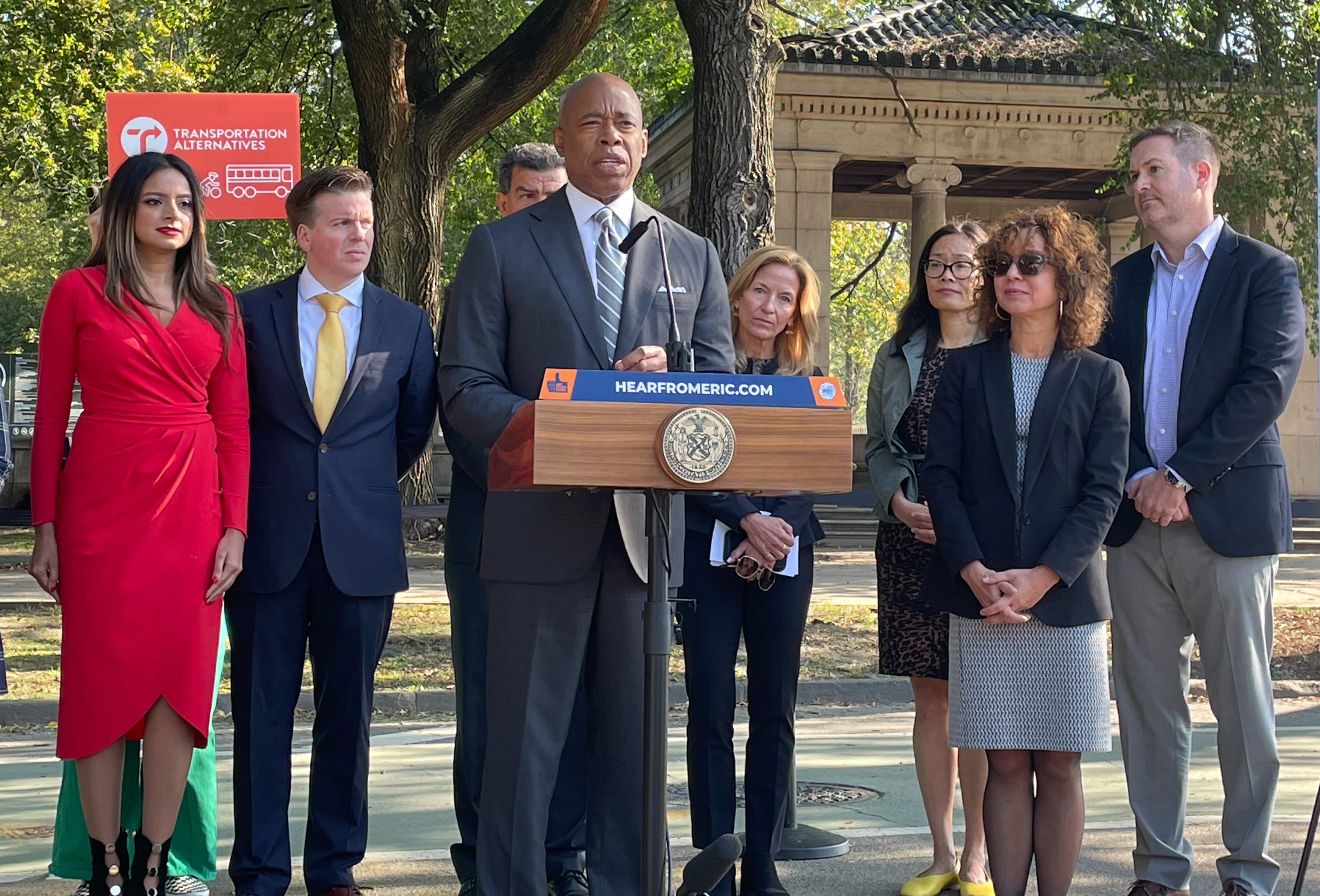Maybe he should be selling encyclopedias, not safer streets.
Mayor Adams, who has said that Mayor Adams and his team have been doing a poor job of conducting community outreach for street redesign projects unveiled a new strategy on Tuesday: His administration is going to go door to door on Underhill Avenue to literally ask all the residents what they think about a bike network improvement that he stalled after more than a year of ... prior community outreach.
The mayor's announcement came as park of a week during which he has defended his decisions to stall or scale-back a variety of previously approved street safety improvements on the grounds that "the community" did not feel it had been fully "heard."
"On Underhill Avenue, we're on the ground, knocking on doors, doing a survey and engaging people in communication," Adams said on Tuesday, ignoring that the Department of Transportation already did multiple rounds of community outreach on it.
Adams told reporters on Tuesday that he wasn't happy with outreach efforts for street redesign projects, which he's been in charge of for almost two years now.
"I believe ... we have not done a good job of speaking to long-term residents on how they want the shaping of their streets to change. When you change the street you are changing the fabric of the community," he said.
Adams's comments followed a similar theme he expressed last week during an announcement of a greenway expansion effort. At that presser, Adams mentioned "community engagement" or "community planning" 16 times — and even let an opponent of some street improvements trash the Emmons Avenue protected bike lane and defend the needs of drivers.
And afterwards, he lectured to activists who called him out for his new insistence that the only real community engagement is one that objects to street safety improvements. Those comments came after Laura Shepard, an organizer for Transportation Alternatives, challenged the mayor to "show leadership" instead of ceding the pro-safety agenda to opponents who "hate change."
"Everyone has an opinion in this city, my role as mayor is to hear all these opinions," Adams told Shepard, adding, "I'm one of the best leaders you've ever seen."
"I cannot emphasize this enough," Adams had said earlier. "That is one of the top complaints we received, people did not feel as though they were engaged. We can't move at such a fast pace that we're leaving communities behind, and every community does not think the same and don't want the same but they do want to have input, and we are going to give them that input."
Fortunately for @NYCMayor, editor @gershkuntzman started knocking on doors on Underhill Avenue for the mayor! See it! https://t.co/Tx1nPLVnOh pic.twitter.com/D7a2lCqIHa
— Streetsblog New York (@StreetsblogNYC) October 17, 2023
By definition, the city can't build a bike network if small groups of residents in each neighborhood get veto power over different segments. And as a record number of cyclists die on city streets, New York City is on pace to fall short of targets for bike lane and bus lane mileage for the second consecutive year. Meanwhile, the Department of Transportation is doing less traditional outreach than it ever has.
According to data compiled by Transportation Alternatives, this year the DOT has made only 52 community board presentations on projects through August, the least since the dawn of the Vision Zero era and 36 percent off the average number of presentations given every year since 2014.

Community board presentations have never been a surefire way of winning neighborhood support for bike lane and bus lane projects, but they've also been the primary place the DOT has those conversations. A community board presentation is also required under a city law that discriminates against projects that benefit cyclists and pedestrians.
They also don't seem to have been replaced by something that makes Mayor Adams happy, despite the fact that he's in charge of that outreach now.
Adams pitched himself during his 2021 mayoral campaign as a difference maker — a leader who would install 150 miles of bus lanes in four years, who would "meet people where they are … and take them where you want them to be."
One reporter lasered in on this seeming contradiction last week, asking how Adams could "talk about taking [street safety changes] slow" while "you've been talking about trying to speed things up." In response, Adams got defensive, citing his championing of the (unprotected) Classon Avenue bike lane in 2017 before he was mayor because "it was the right thing to do." (Community outreach, in that case ... before he was mayor, be damned.)
Nearly seven years later, and now in the decision-maker's chair, Adams has replaced that ethos with a penchant for laughing at elected officials who want his DOT to finish projects with the same exact aims, and an overall decision-making record that's as spotty and inconsistent as his predecessor Bill de Blasio.
De Blasio, for instance, often chose to make safety improvements in the face of strong community opposition, most notably in the case of the protected bike lanes in Sunnyside and his refusal to back down on the 14th Street busway. But de Blasio also found it expedient to throw safety under the bus when the heat was on during his DOT's efforts to redesign Seventh and Eighth avenues in Sunset Park, or finish the Queens Boulevard bike lane.
Adams has also been willing to buck demands to keep streets entirely for motor vehicles in some instances. His DOT followed through on a de Blasio-era project to create the city's first protected bike lanes under elevated subway tracks in the Bronx, and has not pulled the project back even after neighborhood complaints about reduced parking.
But in so many other instances, "the best leader we've ever seen" has been willing to let an entire community engagement process play out and then delay, kill or severely curtail a project that gets through that process. Whether in the form of curtailed busway hours or bus lane and bike lane projects like Northern Boulevard, Ashland Place, Fordham Road or McGuinness Boulevard, the mayor's political allies or donors got City Hall to overrule settled projects that have gone through the public participation ringer.
So contrary to what Adams suggested about his respect for the process and his leadership, advocates said the mayor was too more a weather vane than a strong champion.
"If the mayor is saying, 'Well, we have to just wait and see what people say,' the city of New York is utterly rudderless when it comes to street change," said Bike New York Director of Advocacy Jon Orcutt, who was DOT policy director under mayors Bloomberg and de Blasio.
In addition to the the absence of Adams backing a strong policy vision, his administration also hasn't made any publicized efforts to "meet people where they are," or meet people at all. For a mayor who promised 300 miles of bike lanes and 150 miles of bus lanes, and so far has installed fewer than 50 miles of each, the speed at which he can remake the streets go hand in hand with the ability to lead and communicate.
"Anything that's hard in New York City requires strong and abiding leadership, you can't rotate in and out. You can't just throw up your hands and say, 'Well, people are complaining.' That's not governance. That's not leadership," said Orcutt.
But as Adams's City Hall pulls back on more and more projects, his fallback on process complaints rings hollow when he hasn't bothered to initiate any change in how the city conducts community outreach. So far, his City Hall and DOT has only delivered less of the same broken process.
"The mayor has the ability to put forward a vision for how these processes can happen," said Juan Restrepo, director of organizing at Transportation Alternatives, which staged a mass ride last week to protest the mayor's inaction.
"We've been looking for his leadership on this issue to support numerous projects that have already experienced vigorous community debate and received lots of community support and reflect the needs of a community for safety and for transit equity. These things are already happening — and we need the mayor to back all of the local stakeholders who have been demanding these in larger numbers opposition."






